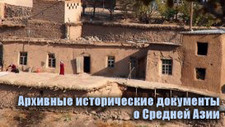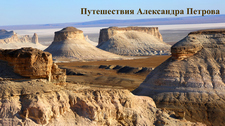Вы здесь
Excursion to Burana Tower.
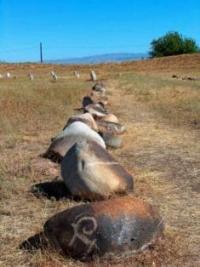
Excursions on archeologic monuments of Kyrgyzstan.
Short description of route of an excursion trip on an architectural-archeological complex Tower of Burana:
Bishkek - settlement Kant - settlement Tokmok - architectural-archeological complex Burana Tower – Bishkek.
Distance of route: 144 km.
Season: all the year round.
Best time for excursion: April - September.
Advanced reservation - for 24 hours.
Duration of excuesion: 1 day.
Detailed program of an excursion trip on Tower of Burana:
"A certain traveler, a Kashgarian, while compiling this book in Balkh, said: once the ruler of Kashgar invaded Mogolistan to condemn and punish the Kalmyks... they reached some area where the roofs of tall buildings protruded from under the sand: minarets, palaces, madrasah arches... the captives were asked the name of this area. They said: we know that there was a city here called Balasagun."
Balkh historian Mahmud ibn Wali. "Bahr al-asrer". ("Sea of secrets regarding noble virtues" or "Sea of secrets regarding high qualities of virtuous people"). 1634 - 1640.
Transfer: Bishkek - Kant city - Tokmok village - architectural complex "Burana Tower" (72 km, 1,5 hours). Arrival at the architectural and archaeological complex "Burana Tower" located on the Burana settlement. In 1976, an open-air archaeological and architectural complex was organized on the basis of the ruins of the Burana settlement.
The territory of the complex is 36 hectares of ruins of an ancient city. Many years of painstaking research by historians and archaeologists give reason to believe that the settlement is the ruins of the ancient city of Balasagyn - the capital of the Karakhanid Khaganate.
From the moment of the formation of the Karakhanid state and up until the Karakhytay conquest (around 1130), Balasagyn, also known as Kuz Ordu, was the main capital or one of the three capital cities of the Karakhanid. In the Middle Ages, the caravan route to the Kochkor Valley passed through this gorge. 6 kilometers northwest of the minaret lie the ruins of the Ak-Beshim (Ak-Peshin) settlement.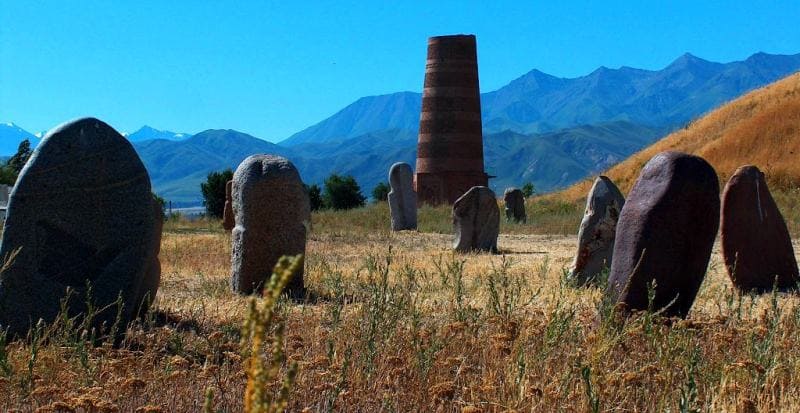
In Kyrgyz folk legends, the minaret appears as a tower, a burial vault, a watchtower, but its true purpose has been forgotten. According to legends, this tower was allegedly built by a powerful ruler named Arslan Khan who once lived here for his only son (or the youngest son who survived), who was predicted by oracles to die from a black widow spider bite.
In the hope of saving the life of the heir to the Khan's throne, the boy and his mother were placed at the very top of the tower so that no evil spirits could enter their chambers. But the black widow spider, which nevertheless brought death to the son (as well as to his older brothers), was accidentally brought in by a servant in a basket of berries.
According to other versions, the only daughter of Arslan Khan appears in the legend. She was protected not only from the black widow spider, but also from the gaze of annoying suitors. After the death of the beauty, which followed from the bite of a poisonous insect, the khan buried his daughter in the same tower where she had previously lived.
Thus, the legend contains a hint of the Burana "tower" as a burial vault of a person of royal blood. The name "Burana" most likely comes from the incorrectly pronounced word "monara", that is, a minaret. On the territory of the architectural and archaeological complex Burana Tower there is a small museum consisting of two halls.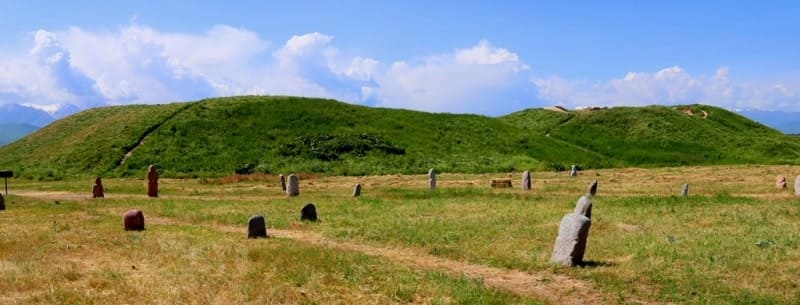
Visiting architectural and complex Burana Tower:
- Burana Museum. In 1976, an open-air archaeological and architectural museum was organized on the basis of the ruins of Burana. The old museum was located in a small house in which artifacts discovered as a result of targeted archaeological excavations were presented in two small halls.
In the autumn of 2016, a new museum was built and opened, its opening was timed to coincide with the 1000th anniversary of Zhusup Balasugun. The museum hall displays clay pottery of various shapes and sizes - from miniature cups to vessels with a capacity of 100 liters or more.
Along with clay pottery, glassware is also on display. Ceramic and bronze lamps are interesting. There are numerous manual grain grinders, kayraks with Arabic and Nestorian scripts, links of pottery water pipes. A rich collection of decorative and applied art items, bronze coins, etc.
- stone sculptures, balbals depicting sculptures of the Turks of the VIth - Xth centuries, located on a field in the southwestern part of the settlement. More than 80 different balbals are presented here. The most carefully made sculptures give a complete idea of the cut of clothing, headdresses, earrings, bracelets, necklaces and other decorations of that time.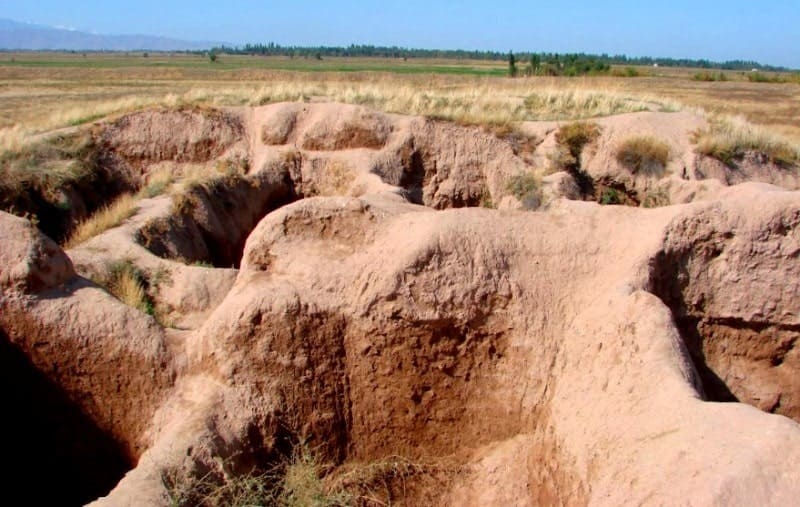
There are, however, in a relatively small number, clearly female figures in a dress of a special style or naked. It is recognized that they appeared in Kyrgyzstan no earlier than the 6th century, i.e. during the period of the emergence of the Turkic Khaganate.
The upper date is presumably determined by the time of the penetration of Islam into the Tien-Shan, i.e. the Xth - XIth centuries. Already at this time, sculptures were used to build Muslim religious buildings. One of them was found near the Burana minaret, another served as a threshold of one of the Karakhanid tombs of Uzgen.
- collections of stone tools found during excavations on the territory of the Burana settlement (Xth - XIIth centuries, millstones from modern mills and threshing stones from the XVIIIth - early XXth centuries. Grain grinders, devices for grinding grain, which are important tools for processing food products.
Threshing stones used for threshing, that is, separating grain from ears. Their presence confirms that agriculture and grain processing were carried out on the territory of Burana in different historical periods: from the Middle Ages (Xth - XIIth centuries) to later times (XVIIth - XXth centuries).
The finds of grain grinders and threshing stones on the Buranino settlement give an idea of the level of development of economic activity of local residents and their way of life in different historical eras, as well as the spread of agricultural technologies on the territory of the Great Silk Road.
- to petroglyphs. Stones with petroglyphs dating from different eras have been collected on Burana - from Bronze Age to the early Middle Ages. On the territory of the architectural and archaeological complex Burana Tower there is a separate paved alley with stones on which rock paintings of the IInd millennium BC - Xth century AD are depicted, the largest number of petroglyphs date back to the VIIIth - IIIrd centuries BC, to the Saka period, to the period of residence of the Saka nomads on the territory of Kyrgyzstan.
The collection of petroglyphs on Burana is not "local". The stones were brought here from various parts of Kyrgyzstan: from Chui, Issyk-Kul, Naryn and other regions, where rich complexes of rock art have been preserved. Thus, Burana has become a kind of open-air museum, where in one place you can see examples of ancient stone art collected from all over the country.
- kayraks (literally "pebble", a gravestone with an epitaph). Visiting epigraphic monuments, which are represented by gravestones with inscriptions in Arabic, on the steles are given sayings from the Koran, the name, year of death of the deceased.
They are dated to the XIVth and first half of the XXth centuries. Epigraphic monuments were found in places near the architectural and archaeological complex of the Burana Tower.
- minaret of Burana Tower. Burana Tower is a minaret of the XIth century. The original height of the Burana minaret was 45 meters, now the height of the tower is 24.6 meters. According to scientists, the tower was built in the 11th century. The architectural structure of the Burana Tower served as a minaret and a watchtower.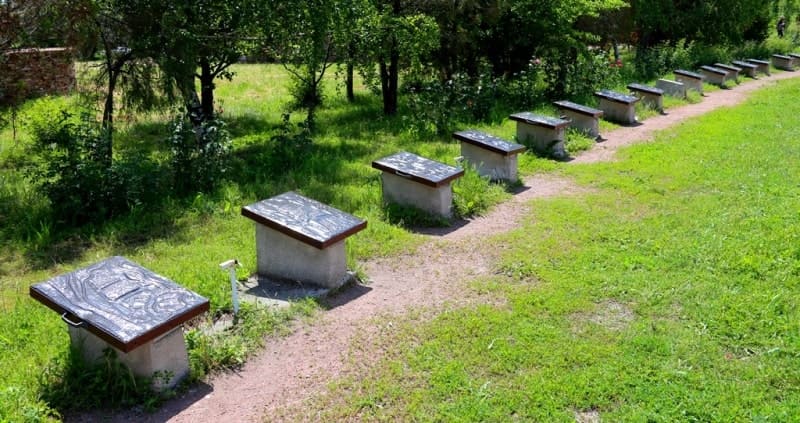
The surviving Burana minaret once belonged to the cathedral mosque. It was built in the newly rebuilt city at the end of the 10th or beginning of the 11th century during the period of mass Islamization of the Semirechye Turks. This is the earliest of the surviving monuments of tower architecture in Central Asia.
Archaeological explorations and excavations at the minaret were carried out in 1925, 1960 and 1970 – 1974.
- central ruins, where there is a hill measuring 100 x 100 meters and 10 meters high, which hides the remains of a palace complex or temple that existed here until the 10th century. Excavations carried out on the hill, on its upper area, uncovered residential buildings of the Xth - XIIth centuries and burials of the XIIIth - XIVth centuries.
- mausoleums. During the period 1970 - 1975, D. F. Vinnik uncovered the remains of four religious medieval structures in the central part of the settlement. Mausoleum No. 1 is located 24 meters southeast of the minaret, among Muslim graves of varying states of preservation, built at different times; mausoleum No. 2 was located on a fairly elevated platform near the floodplain of the Burana River, 70 meters northeast of the "tower".
Judging by the microrelief, it was not the only one. In subsequent years, another completely identical mausoleum was excavated here.
Return to Bishkek (72 km, 1,5 hours). End of excursion.
Note:
Program is Alexander Petrov's author's program. Copying and introduction - only from sanction of author.
Alexander Petrov
photos by.





